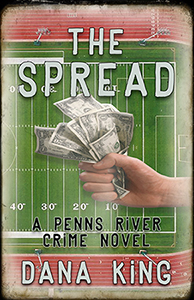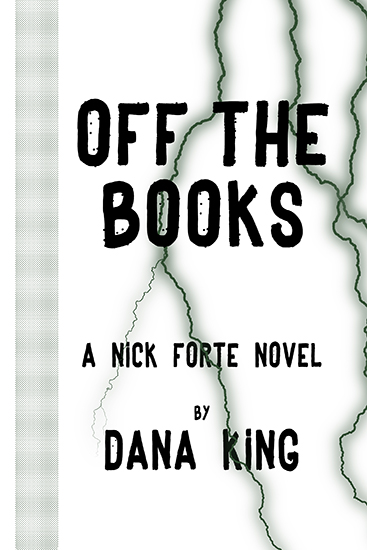I knew the name J.L.
Abramo well before I interviewed him last year, but didn’t meet him in person
until the Shamus banquet last fall in New Orleans, where he won for Circling the Runway. It’s always fun
when someone with a reputation such as Joe’s turns out to be a true gentleman.
He could not have been nicer about crushing my dreams, both of us nominated for
the same award. Much as I wanted to hate him, I couldn’t pull it off. (It’s
okay. Joe’s from Brooklyn. He understands that kind of humor.)
Joe was not only born in
Brooklyn, but on Raymond Chandler’s birthday. (Must be something about July 23
and writers.) He is the author of Catching Water
in a Net, winner of the St. Martin's Press/Private Eye Writers of America
prize for Best First Private Eye Novel; the subsequent Jake Diamond novels Clutching at Straws, Counting to Infinity
and Circling the Runway; Chasing Charlie
Chan, a prequel to the Jake Diamond series; and the stand-alone thrillers Gravesend, Brooklyn Justice, and Coney
Island Avenue, which is why he’s here today.
His short fiction has appeared in the
anthologies Unloaded: Crime Writers
Writing Without Guns; Mama Tried: Crime Fiction Inspired by Outlaw Country
Music; Coast to Coast: Private Eyes from Sea to Shining Sea and Murder Under the Oaks, winner of the
Anthony Award for Best Anthology of 2015.
It’s a pleasure to get to pick his brain
again, and on the day Coney Island Avenue
drops, when I know he has plenty on his mind.
One
Bite at a Time: Thanks for taking the time to chat today, Joe.
It was a treat to be at the Down & Out table with you when you won the
Shamus Award last year in New Orleans for Circling
the Runway. How did it feel to win?
J.L.
Abramo: First, let
me say, it is a pleasure to be back for One
Bite at a Time. Talking with you last year about Brooklyn Justice was a treat
for me—I admire and appreciate an interviewer who poses smart, challenging and
thought-provoking questions and displays a familiarity with the work being
discussed. Does their homework. (Editor's Note: Aw, shucks. I told you he was a gentleman.)
Earning the Shamus
Award for Circling the Runway was
very special to me for many reasons. Circling
the Runway was the fourth in the Jake Diamond series which began with Catching Water in a Net in 2001. (Although
Chasing Charlie Chan, published in
2013, is related—the events in that
novel taking place some years before the beginning of Catching Water in a Net—Jake Diamond plays only a minor role.)
Catching
Water in a Net received the St. Martin’s Press/Private
Eye Writers of America Award for Best First Private Eye Novel of 2000—and was
published by SMP the following year.
St.
Martin’s Minotaur gave me two more shots (Clutching
at Straws, 2003 and Counting to
Infinity, 2004) before deciding the Jake Diamond series, though well
received by critics and readers alike, was not what they considered a money maker. I continued to write, of
course, what other choice did I have—but the work seemed destined to remain out
of the public realm. And then, the net
held water once again when Eric Campbell of Down & Out Books reached out to
me and gave Jake Diamond and J. L. Abramo a second shot. D&O quickly re-issued the three Diamond
private eye mysteries.
Old
and new fans kept asking if Jake would ever return. I wondered if after more
than a decade away I would still know Jake
and his regular band of cohorts. I found writing the novel was much like a
reunion with old friends. (Re-reading the earlier books helped—reminding me how
funny Jake could be.)
Circling the Runway was
the first new Jake Diamond novel
published in nearly a dozen years (Gravesend
and Chasing Charlie Chan preceding
it) and earning the Shamus was an affirmation that the series was still viable
after a long hiatus—and a validation by fellow private eye novelists that the
work was worthy. Earning an award
decided upon by your peers is most rewarding.
OBAAT:
You’re well-known for your Jake Diamond series. What made you switch to a
police procedural when you wrote Gravesend?
JLA: Actually, the seeds of Gravesend were sown before Jake Diamond. It was a work which developed for many years
and in its final incarnation was given a chance to see the light of day thanks again
to Down & Out Books.
Gravesend is
about people who happen to be police
detectives or criminals or in the neighborhood.
I was writing about how lives intersect—often accidentally and sometimes
unknowingly. I was treating Brooklyn as
a small town—which for all its size it had always felt to me when I was growing
up in Gravesend. Writing Gravesend was a return to the place of
my origin—more a change of setting from Jake Diamond’s San Francisco to my
hometown, Brooklyn, than a change from one sub-genre to another. It was a chance to rediscover for—as T.S.
Eliot put it—We shall not cease from
exploration and the end of all our exploring will be to arrive where we started
and know the place for the first time.
And although Gravesend is
crime novel on the surface—the book evolved into its present incarnation when I
finally understood what I was humbly attempting to explore—namely how the
manner in which human beings handle adversity will ultimately define them as
persons—good or evil—weak or strong—fair or unjust—loved or despised—admired or
feared.
OBAAT:
Coney Island Avenue is the sequel to Gravesend. Tell us a little about it.
JLA: I never really planned to write a follow-up
to Gravesend. Gravesend was a very ambitious and
personal novel—it had been developing for a long time—and I was proud of the
work. I feared it might be too hard an
act to follow. But I received lots of
encouragement from readers who wanted to hear more about the characters and
where they might venture—and I found myself wondering also—so I picked up where
Gravesend left off and wrote a sequel which is a crime novel and also very
much about parents and children.
OBAAT:
It’s always interesting to talk with an author who switches between sub-genres
as you do, probably because I do it myself. Do you take a different approach
when working on a PI novel as compared to your procedurals? I’ve thought for years that PI stories and
procedurals are each uniquely suited to telling different kinds of stories.
Police have to take whatever cases come to them—and they have to close them.
PIs sometimes have a chance to look for closure. Do you see fundamental differences in the
genres?
JLA: I think I approach all of my writing in the
same way. I begin with a scene, a situation, which stimulates my
imagination and which I hope will draw the reader in—and what follows is the
journey.
I
see genre as the vehicle for that journey—the vehicle in which the writer is
most comfortable—be it crime, mystery, science fiction, etc.
That
being said, I agree that some situations are better served by different types
of protagonists—some more suited to the private investigator, often working alone, and others more suited to a team of police investigators.
The
Diamond novels tend to be lighter, less
intense, more humorous due to his personality—although Murphy does provide comic relief in the precinct
novels.)
As
a private investigator, Diamond may require or depend on assistance from friends and colleagues and Jake is often
at odds with the SFPD—whereas the detectives of the Six-One count on and expect back-up from each other.
The
private eye novel can get away with focusing on one case, but I see police
detectives in a large city usually working a number of cases at once.
As
you mentioned, police feel pressure to close a case—from the public, the city
politicians and media—which the private eye may not have to face. Unless, of
course, solving the case is a matter of life and death.
OBAAT:
Moving back to Coney Island Avenue
and the 61st Precinct, I’d be remiss if I didn’t ask your opinion of Ed McBain
and his 87th Precinct novels and whether they had any effect on you.
JLA: Ed McBain, NYPD Blue, Blue Bloods, Serpico—these
and other books, TV and films involving police officers and detectives have
always appealed to me and certainly inspire me to explore and conscientiously
depict the kinds of challenges faced by law-enforcers both on the job and in their personal lives.
OBAAT:
New York police stories tend to focus on Manhattan. What appeals to you about Brooklyn?
I don’t mean that to sound like a pejorative. I like stories that aren’t set in
the same old places.
JLA: As I mentioned earlier there is a small town character unique to Brooklyn
even though by population it would be the fourth largest city in the United
States—and when writing a book that is character and dialogue driven what
better place to set it than the Borough of colorful characters and speech.
This piece I wrote about my little town says it as
well as I could: http://jlabramo.blogspot.com/2016/03/brooklyn-ease.html
OBAAT:
Your 61st Precinct books are ensemble pieces. Do you have to plan differently
when you have so many moving pieces?
JLA: I have always loved classic literature—as
does Jake Diamond. Diamond is reading a
classic novel in each book—one that has parallels to the story at hand.
I particularly enjoy
books with a lot of individual characters—so I tend to write that way. I
remember early on a reader saying he thoroughly enjoyed Catching Water in a Net but had trouble at times keeping the many characters
straight. As a reader, I was used to
books with a large number of characters—Dickens, Dostoyevsky, Hugo—so I am good
at keeping it all straight in my head as I read and write. But I tend to forget
it is a lot to keep track of for some readers.
So, since Catching Water in a Net,
I have included a Cast of Characters at
the beginning of each book for back reference—and it seems to work. And, also, perhaps my books are ensemble pieces because of my theatre
background.
I don’t really plan the
number of characters—they just keep showing up as the stories progress.
OBAAT:
Who’s your favorite character of the 61st Precinct ensemble?
JLA: I like many of the characters—enough to have
decided to bring them back—but if I had to pick one favorite it would be
Detective Thomas Murphy. Murphy is very
Brooklyn. He is funny. He is tough and vulnerable at the same
time. He is honest and loyal. And he has a dog named Ralph.
OBAAT:
Do any of them give you trouble?
JLA:
For the same reasons I like Murphy, he gives me the most trouble. He can be
taken the wrong way if I am not careful. He has a Brooklyn sense of humor some
might take as sarcastic and a Brooklyn cynicism some might consider
defeatist. But he is neither.
It is Murphy who says: There are degrees of guilt, shades of
innocence—and they all congregate on the same avenue—which is, to a great
extent, what Coney Island Avenue is
about.
Since I have spent a
good deal of time in places outside of Brooklyn assuring people I wasn’t making
fun of them and I really think the world is a pretty cool place, I know the
dangers of being misunderstood—so I need to keep a close eye on Murphy to assure
he remains a likeable and sympathetic character.
OBAAT:
You’ve had quite a career as an author and obviously still going strong.
Looking back, what do you find the most satisfying and what has surprised you
the most?
JLA: Most satisfying is hearing from readers that
the work has affected them in some positive way—even if it is simply you made me laugh.
Most surprising is that
they haven’t made any movies yet.
OBAAT:
Thanks again for stopping by. It’s been a treat for me and I hope to see you in
Toronto, if not before. Before we call it a day, what are you working on now? Do you have plans beyond that, or are you
strictly a one book at a time guy?
JLA: I am working on a novel about two Sicilian
families who bring their blood-feud from the old country to New York City and San Francisco in the early years
of the 20th Century and slug it out over the course of nearly 100
years. Romeo and Juliet meet the
Hatfields and McCoys.
What follows will be
strictly up to my muse.
For more about Joe and
his work please visit:






No comments:
Post a Comment